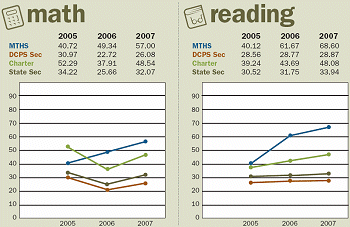Extracurricular :: For technologists who do their homework
As Mary Ann Wolf, the executive director of the State Educational Technology Directors Association(SETDA) explains at length in High Schools : An Equation That Works, technology-aided instructionalpractices are key to successful teaching in the areas of science, technology, engineering, and math-- known collectively as STEM. The performance of students at tech-infused McKinley Technology HighSchool in Washington, DC, over the past three years testifies to that.
As shown, in the first three years of standardized testing data since MTHS opened in fall 2004, math scores atthe school rose substantially, well exceeding the performance of students at other DC-area secondary schools. Atechnology-rich environment that gets students interested in STEM subjects naturally fosters their interest inother academic areas, paying off in higher achievement. Witness the upward spike in reading scores.


The charts show the average standardized test scores of students at McKinleyTechnology High School and the average scores of secondary students in the city’sother public schools and its charter schools, along with the average scores of the lattertwo groups of students combined. The Stanford Achievement Test, Ninth Edition (SAT-9),was administered in 2005, while the District of Columbia Comprehensive AssessmentSystem (DC-CAS) was given in 2006 and 2007.
Source: Teaching Institute for Excellence in STEM (TIES).